
Opinions expressed here are ours alone, and are not provided, endorsed, or approved by any issuer. Our articles follow strict editorial guidelines and are updated regularly.
Credit cards and cash are two of the most popular payment methods consumers use to purchase goods and services. Both types of payments offer consumers benefits. Whether a consumer reaches for their credit card or cash to complete a particular transaction can depend on personal preferences and circumstances.
Even as new forms of payment become available, Americans continue to reach for their credit cards or cash to pay for goods and services. Here are 25 fascinating statistics that shed light on recent consumer credit card and cash usage trends.
1. More than 40% of Americans Don’t Use Cash in an Average Week
Think about all the activities you’re involved in in a typical week — going to work, completing household chores, spending time with family. A financial transaction commonly accompanies each of these actions. Perhaps it’s the cup of coffee you purchase each morning on the way to work or the gasoline you buy for your lawn mower. Do you use cash to complete any of these transactions?
If you answered ‘no’, you are not an outlier. More than 4 out of 10 US adults don’t use cash at all in a typical week. Conversely, 14% of US adults use cash for all or almost all of their weekly purchases.1
2. Cash is More Popular Among Individuals With Lower Incomes
Americans with lower incomes have a higher propensity to use cash on a weekly basis than those with higher incomes. Thirty percent of adults with annual household incomes of less than $30,000 use cash for all or almost all of their weekly purchases. As incomes rise, Americans tend to use less and less cash. Only 4% of American households making more than $100,000 a year use cash for all or almost all of their weekly purchases.1
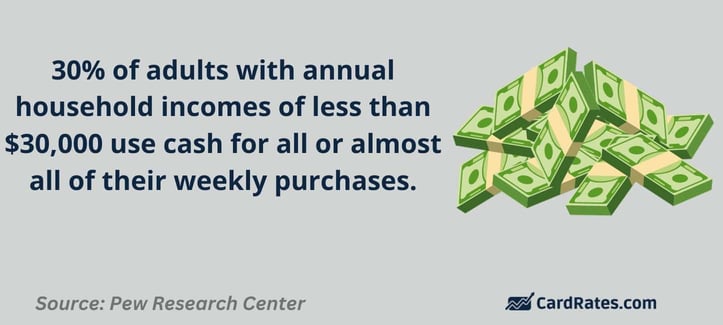
Interestingly, there isn’t much difference in the proportion of households earning less than $30,000 annually who say they don’t use cash for any of their typical weekly purchases. About 24% of low-income households say they don’t regularly use cash for any of their weekly purchases.
3. Carrying Cash is a Preference for 58% of Americans in Case it’s Needed
Although many Americans choose to use a payment method other than cash when paying for an item or service, they tend to follow a safety-first approach to carrying cash.
Payment-acceptance terminals aren’t infallible. Power outages and online connectivity issues can render card readers ineffective. Even if they’re not planning on using cash, consumers who carry cash enjoy the peace of mind that they have a backup payment method when other forms of payment aren’t accepted.
More than half (58%) of Americans carry cash with them for just-in-case purposes. For Americans over the age of 50, the percentage who carry cash just in case they need it jumps to 71%.1
4. Gen Z’s Cash Usage is Increasing
The oldest members of Generation Z (Gen Z) — the demographic born between 1997 and 2012 — are beginning to wield their spending power as they graduate from school and secure their first full-time jobs. Gen Zers are also using cash more frequently to complete their transactions.
Nearly 70% of Gen Zers said they use cash more often than they did 12 months ago. Gen Z’s increased use of cash far outpaces the increased use of cash by other, more established age groups.2
Only 47% of Generation X survey respondents said they use cash more regularly than they did 12 months ago, and just 37% of baby boomers respondents said they have increased their cash usage over the past year.
5. Nearly 1 in 4 Gen Zers Use Cash for the Majority of Purchases
In addition to using cash more frequently, roughly one-fourth of Gen Zers also use cash exclusively to complete their transactions. Some 23% of Gen Z respondents surveyed said they use cash to make most of their purchases, including grocery (50%) and clothing purchases (46%) and more nonessential items such as takeout food (40%) and coffee (40%).2
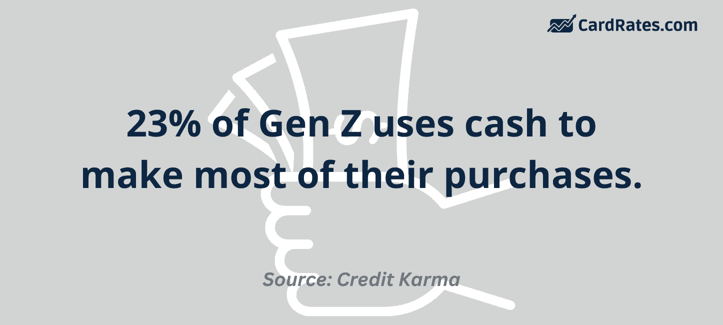
In a study conducted by The Harris Poll, Gen Z respondents said they prefer to use cash instead of other forms of payment because it helps them budget their money. Gen Zers also cited a tendency to spend less money when completing purchases with cash as a reason for exclusively using cash.
6. The Majority (82%) of Adults Own a Credit Card
Using a credit card over cash has many benefits. Consumers making large-dollar purchases with a credit card don’t have to worry about carrying a bulky stack of cash to their point of purchase. A credit card can fit in nearly any pocket or wallet.
A consumer who misplaces their credit card may have to deal with the logistics of canceling their card and ordering a new one. But those who misplace cash have fewer, less attractive options for restitution.
Though credit card uses vary from person to person, an overwhelming majority of adults in America (82%) own a credit card.3
7. Credit Card Ownership Grows as Family Income Rises
Only 57% of US adults with an income less than $25,000 own a credit card. And 56% of the cardholders making less than $25,000 carry a balance on their card from month to month at least once per year.3
The percentage of adults in America who own a credit card rises as income levels rise. Most adults (98%) earning $100,000 or more per year own a credit card; of that group, only 38% carry a balance from month to month at least once per year.
Individuals earning from $25,000 to $49,999 a year are the most likely to carry balances from month to month, according to the study. More than half (57%) of those who earn an income within this range do not pay off their monthly balances each month.
8. Most Adults Over the Age of 60 Have a Credit Card
The average retirement age in the US is 61.4 Those who’ve worked for most of their lives may target their retirement as a time to enjoy themselves and cross some items off their bucket list, including traveling or taking on a new hobby.
| Age | Percent Owning a Credit Card |
|---|---|
| 18-29 | 67% |
| 30-44 | 79% |
| 45-59 | 86% |
| 60+ | 92% |
While owning a credit card isn’t likely to be on anyone’s bucket list, those aged 60 and older are more likely to own a credit card than any other age group. The majority of adults (92%) over the age of 60 own a credit card compared to 67% of people 18 to 29 who own a credit card. The rate of credit card ownership for those between the ages of 30 to 44 stood at 79% and 86% for people ages 45 to 59.3
9. Asians Are More Likely Than Other Ethnicities to Own a Credit Card
In 2020, the real median annual household income of households headed by Asian people outpaced annual incomes of households headed by people of other ethnicities by almost $20,000, according to the U.S. Census Bureau.5
Asians also have higher rates of credit card ownership than any other demographic group in the US. The majority (92%) of Asians in the US own a credit card. Of those, only 27% report carrying over a monthly balance at least one month per year.3
10. Global Cash Transactions Are Declining
Advances in payment-acceptance technology aren’t unique to the US Across the world, consumers enjoy the convenience and efficiency of paying for goods and services with their cards or digital options.
Cash is still a relevant point-of-sale payment method accepted by many merchants worldwide, but the prevalence of cash payments are declining. Cash purchases account for approximately 16% of the value of global point-of-sale transactions. By 2026, industry experts expect the value of global point-of-sale transactions made via cash to drop to 10%.6
The pace at which countries are transitioning to cash differs. Thailand is estimated to use cash for 32% of its point-of-sale transactions by 2026, while analysts expect France to use cash for only 5% of similar transactions.
11. Credit Cards Are the Most Popular POS Payment Method
After a long day of shopping, reaching the register can feel like crossing the finish line of a race. You’ve endured the traffic while traveling to your shopping destination. You’ve braved through crowded corridors of shoppers and in-store displays to select your items for purchase. Now that you’ve finished shopping, you expect a quick and easy purchase experience.
Using cash can prolong a point–of–sale transaction — the buyer must first count and hand the register attendant the money and then wait for the attendant to provide them with change. Using a credit card for the transaction eliminates the need for handing cash back and forth.
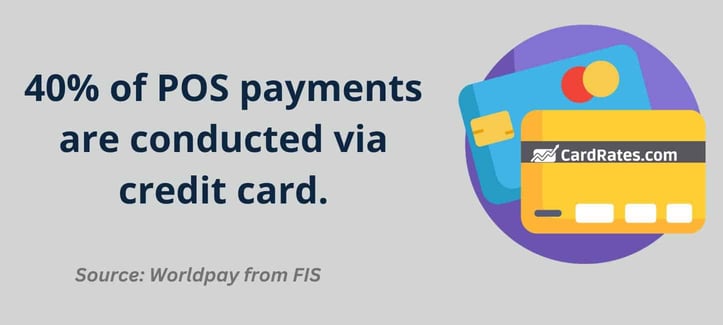
Credit cards are the leading payment method at the point of sale in the US, accounting for 40% of all such transactions.6
12. One-third of eCommerce Transactions Are Via Credit Card
Consumers who engage in online shopping can purchase goods and services from businesses around the world without ever stepping foot out of their front door. Completing an online transaction requires just two primary elements: an internet-connected device and a payment method.
Credit card transactions account for 30% of the value of all US eCommerce transactions.6
Unsurprisingly, cash is one of the least popular payment methods for eCommerce transactions. Just 1% of the value of eCommerce transactions comes from cash-on-delivery payments.
13. Global Credit Card eCommerce Transactions Exceed $1.2 Trillion
Advances in payment-acceptance software have rendered cash transactions less common than they were in recent years. Parties can’t instantly transmit physical cash to each other, but buyers and sellers can instantly and securely transmit credit card information to complete a transaction.
In addition to entering credit card payment details into online shopping portals to complete purchases, consumers can also upload their credit card information to digital wallets.
The value of all global credit card eCommerce transactions is $1.2 trillion. Industry analysts expect this figure to grow rapidly in the near future, expanding to $1.4 trillion by 2026.6
14. Rate of American Shoppers Using Virtual Cards: 37%
The popularity of virtual cards, which can be used instead of physical cards when completing online transactions, is rising. In the US, 37% of consumers have used a virtual card when shopping online. Another 29% of US citizens have heard of virtual cards but haven’t used them yet.7
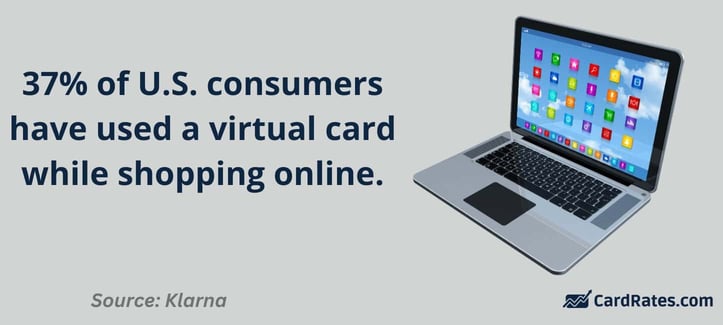
The number one reason consumers around the world use virtual cards is the convenience they offer. Consumers also cite the increased privacy and security of virtual cards as a reason for their popularity.
Additionally, US consumers believe virtual cards are more environmentally sustainable than their physical counterparts.
15. Millennials Using Virtual Cards: 81%
Virtual cards appear poised for an explosion in popularity in the coming years. In the US, 73% of consumers would rather make future online purchases with virtual cards. Only Spain and Italy — where 80% and 76%, respectively, of consumers surveyed say they would rather use virtual cards for future online purchases — indicate a greater preference for virtual cards.7
Virtual cards are more popular among younger generations. In the US, 81% of millennials surveyed say they would prefer making future online purchases with a virtual card.
Most Gen Z and Gen Xers, 75% and 72%, respectively, also said they favor virtual cards for future online purchases. Conversely, only 55% of baby boomers indicate they’d prefer using virtual cards in the future.
16. Nearly two-thirds of Americans Believe Society Will Become Cashless
With all the new payment methods that have emerged throughout the 21st century, and the likelihood of more on the way, it may seem that society is trending toward becoming cashless. Will some form of cash continue to be used in the future? Most Americans don’t think so.
In fact, 64% of Americans said they believe society will become cashless during their lifetimes.8 Of this group, 29% feel a cashless future is very likely to occur. Only 15% feel it is very unlikely the US will become cashless in the future.
Just because Americans envision a cashless future doesn’t mean they necessarily want the future to be cashless. Just over half of US adults say they would be upset if the country became cashless. Only 9% said they’d be happy to live in a cashless society.
17. Adults 30 to 40 Years Old Comfortable Without Cash
The variety of payment methods available today has made US adults feel more comfortable leaving their homes without carrying cash. Though the number deviates significantly by age group, 43% of US surveyed adults said they are comfortable not having cash on them outside the home.8
Those ages 30 to 49 are the most comfortable without carrying cash. Fifty-five percent of those aged 30 to 49 in the survey said they are comfortable without cash. On the other hand, only 26% of those ages 65 and older said they are comfortable without cash.
| Age | Percent Comfortable Without Cash Outside the Home |
|---|---|
| 18-29 | 54% |
| 30-49 | 55% |
| 50-64 | 36% |
| 65+ | 26% |
Political affiliation appears to play a role in an individual’s comfort with going cashless. Sixty percent of Republicans say they’d be upset if the US were to become cashless. Only 28% of Democrats felt the same way.
18. Credit Cards Trail Debit Cards For Most Popular Payment Method
Though credit card usage has increased in recent years and overtaken cash as a popular form of payment, credit cards still trail one form of payment in volume — debit cards. According to a report by the Federal Reserve, when considering all payments, debit cards account for 29% of transactions, and credit cards account for 28%.9
Debit card transactions have been more popular than credit card transactions for six years in a row, but the difference in their level of popularity has decreased. If this trend continues, credit cards may soon overtake debit cards in popularity.
Together, debit and credit card transactions represent 57% of all consumer payments.
19. Consumers Prefer Cash Over Credit Card for Smaller Purchases
One attractive feature of credit cards is they allow consumers to purchase an item today and pay for it later. Credit cards are also useful for accommodating impulse purchases. The credit-card-carrying consumer doesn’t need to worry about having enough cash in their wallet to complete a transaction.
But for smaller purchases, carrying sufficient cash is less of a concern. Consumers make an average of 12 in-person payments per month that are less than $25 each.9 Consumers use cash to complete those transactions an average of five times per month, which is more often than any other payment vehicle.
20. On Average, Americans Carry $67 in Cash
To consumers who aren’t ready to completely give up on carrying cash, the question looms: Exactly how much cash should one carry? The answer to that question depends on factors such as the cost of living in a consumer’s region and access to other payment methods.
On average, Americans carry $67 in cash with them daily. There are considerable differences in the amount of cash individuals of different age groups carry.9
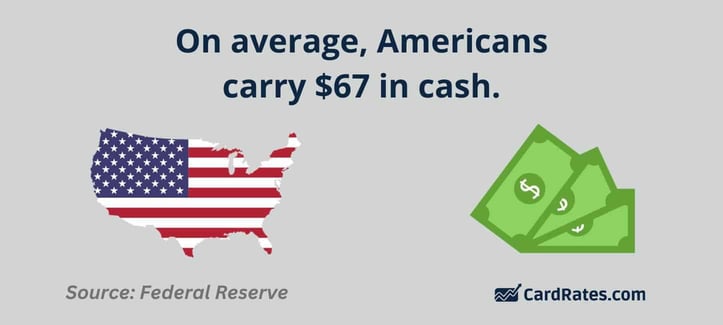
Those aged 65 and older carry an average of $101 in cash daily. On the other hand, those aged 25 to 44 carry an average of $47 with them daily.
21. High Earners Carry Approximately $50 More in Cash Than Low Earners
There is a correlation between the amount of cash one carries each day and their income level. Those who make more money typically have more cash on hand than their lower-earning counterparts.
Individuals with an income of $100,000 to $124,999 on average carry $83 with them each day.9 Interestingly, there isn’t much difference in the cash-carrying habits of those earning higher incomes. Workers making $125,000 or greater carry an average of $84 daily.
The lowest average daily cash-on-hand levels belong to those who earn less than $25,000 annually. These earners carry an average of $39 per day.
22. Travel Expenses Are the Largest Monthly Credit Card Purchases
Thus far, we’ve mainly focused on the method consumers use to make payments, but we haven’t examined what purchases consumers make using their credit cards.
Travel accounts for the most significant monthly spend category for credit card purchases. On average, consumers charge $822 of travel-oriented purchases on their credit cards each month.10 This figure accounts for nearly 17% of all credit card expenditures each month.
Credit cardholders spend another $168 on gasoline, a separate travel category, each month, accounting for 3.4% of the average monthly credit card bill.
23. Food-Related Purchases Account for Over 23% of Monthly Credit Card Expenses
If restaurant and grocery purchases fell into one category, they would represent the largest spending category of credit card purchases by far.
Taken into account together, restaurant and grocery purchases account for over 23% of monthly credit card spend.10 Restaurant spend slightly outpaces grocery spend, accounting for 11.6% of monthly credit card purchases compared with the 11.5% spent on groceries.
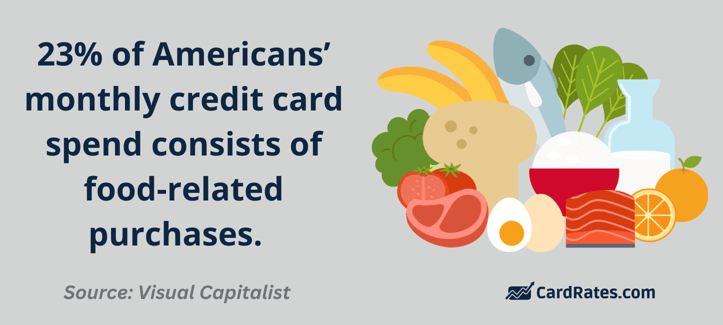
Other popular credit card expenditures fall into the general merchandise category, accounting for 16.7% of monthly credit card spend, and clothing purchases, which account for 10.7% of monthly credit card purchases.
24. The Number of Credit Card Payments Made Per Year Has Skyrocketed
The sheer number of credit card payments made each year is staggering. According to the 2022 Federal Reserve Payments Study, the number of credit card payments made yearly has grown to over 51 billion.11 The average ticket price of those 51 billion transactions is $96.
The Federal Reserve’s study measures credit card payments, for both volume and total spend, every three years. The number of credit card payments increased by 6.3 billion between 2018 and 2021. The value of credit card transactions during that period increased by $900 billion.
25. ATM Cash Withdrawals Are Declining
Cash payments may be on the decline, but cash is still a force on the consumer payment landscape. ATMs remain a popular place for consumers to withdraw cash, though they’re used less frequently today than in recent years.
ATM cash withdrawals dropped to 3.7 billion in 2021, according to the 2022 Federal Reserve Payments Study.11 That represents a decrease of 1.4 billion ATM cash withdrawals since the 2019 version of the study.
Though ATM cash withdrawals are declining, the study reveals that they still occur quite frequently — on average, over 10 million ATM cash withdrawals are performed each day.
Credit Card and Cash Remain Viable
A consumer’s age, income level, or even the type of transaction they’re performing can influence their decision to use a credit card or cash — and preferences differ from person to person.
Though each has its unique benefits, cash and credit cards remain viable spending tools for consumers in the US and around the world.
Data Sources:
1https://www.pewresearch.org/short-reads/2022/10/05/more-americans-are-joining-the-cashless-economy/
2https://www.creditkarma.com/about/commentary/cash-is-king-for-gen-z-as-cash-stuffing-trend-catches-on
3https://www.federalreserve.gov/publications/files/2022-report-economic-well-being-us-households-202305.pdf
4https://news.gallup.com/poll/394943/retiring-planning-retire-later.aspx
5https://www.census.gov/content/dam/Census/library/visualizations/2021/demo/p60-273/figure2.pdf
6https://www.fisglobal.com/-/media/fisglobal/files/campaigns/global-payments-report/FIS_TheGlobalPaymentsReport_2023.pdf
7https://insights.klarna.com/mobile-shopping/
8https://news.gallup.com/poll/397718/americans-using-cash-less-often-foresee-cashless-society.aspx
9https://www.frbsf.org/wp-content/uploads/sites/7/2022-Findings-from-the-Diary-of-Consumer-Payment-Choice-FINAL.pdf
10https://www.visualcapitalist.com/sp/a-breakdown-of-americans-monthly-credit-card-spending/
11https://www.federalreserve.gov/paymentsystems/fr-payments-study.htm



![25 Shocking Credit Card Processing Statistics ([current_year]) 25 Shocking Credit Card Processing Statistics ([current_year])](https://www.cardrates.com/images/uploads/2023/11/Credit-Card-Processing-Statistics.jpg?width=158&height=120&fit=crop)
![[current_year] Credit Card Debt Statistics (Average U.S. Debt) [current_year] Credit Card Debt Statistics (Average U.S. Debt)](https://www.cardrates.com/images/uploads/2018/04/shutterstock_243114739-edit.jpg?width=158&height=120&fit=crop)
![15 Disturbing Credit Card Fraud Statistics ([current_year]) 15 Disturbing Credit Card Fraud Statistics ([current_year])](https://www.cardrates.com/images/uploads/2020/08/shutterstock_576998230.jpg?width=158&height=120&fit=crop)
![21 Startling Credit Card Data Breach Statistics ([current_year]) 21 Startling Credit Card Data Breach Statistics ([current_year])](https://www.cardrates.com/images/uploads/2023/10/Credit-Card-Data-Breach-Statistics.jpg?width=158&height=120&fit=crop)
![11 Surprising Teen Credit Card Statistics ([current_year]) 11 Surprising Teen Credit Card Statistics ([current_year])](https://www.cardrates.com/images/uploads/2023/10/Teen-Credit-Card-Statistics.jpg?width=158&height=120&fit=crop)
![18 Revealing Credit Card Ownership Statistics ([current_year]) 18 Revealing Credit Card Ownership Statistics ([current_year])](https://www.cardrates.com/images/uploads/2023/11/Revealing-Credit-Card-Ownership-Statistics.jpg?width=158&height=120&fit=crop)
![21 Eye-Opening Student Debt Statistics ([current_year]) 21 Eye-Opening Student Debt Statistics ([current_year])](https://www.cardrates.com/images/uploads/2020/11/shutterstock_674141887.jpg?width=158&height=120&fit=crop)